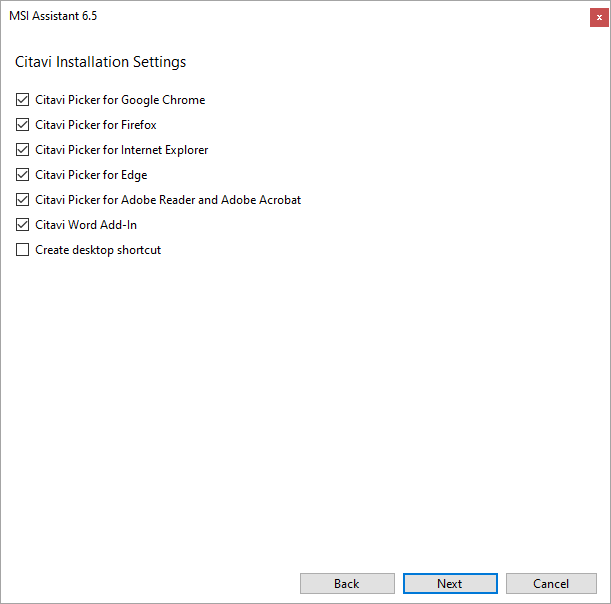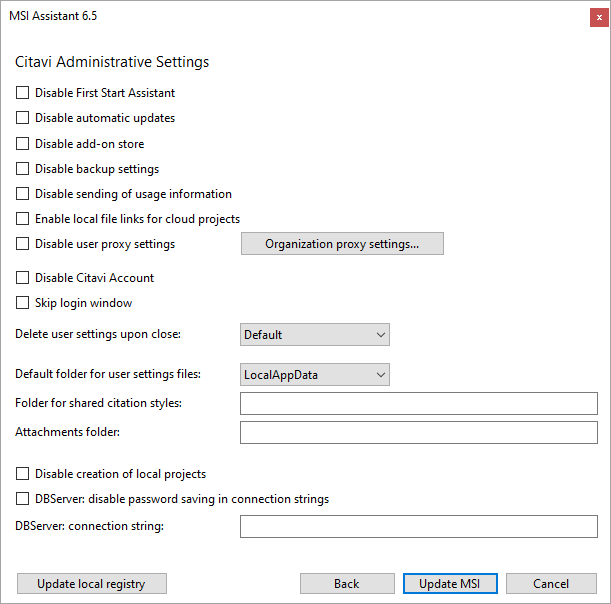Using the MSI Assistant
To deploy Citavi 6 in an organization using a software distribution system, you should use the MSI Setup, which you can download from our website. Use the MSI Assistant (download here) to configure Citavi.
Important:
To use the MSI Setup make sure that .NET Framework 4.8 (or later) is already installed on all computers.
Select add-ins and extensions
First, select which add-ins and extensions should also be installed:

Selecting program features
Select which features should be disabled and which default folders should be used:

These settings will be entered in the Windows Registry:
- on 64-bit computers: HKLM\Software\Wow6432Node\Swiss Academic Software\Citavi 6\AdminSettings (additional information)
- on 32-bit computers: HKLM\Software\Swiss Academic Software\Citavi 6\AdminSettings
Example:
As a system administrator in a company setting you want to ensure that users do not log in to Citavi Account or use the Citavi Cloud. In addition, users should not see update noifications. You would select the following options:
- Disable Welcome Screen
- Disable automatic updates
- Disable Citavi Account
- Disable Login Window
Command
Disable First Start Assistant
The first time they start Citavi 6, users will not see the First Start Assistant which helps them convert their projects from previous versions.
Disable automatic updates
Citavi will not automatically check for program updates.
Disable add-on store
Citavis add-on manager (Tools > Manage add-ons) and the online macros for the Citation Style Editor are not displayed and/or are blocked. This option does not affect the manual installation of add-ons via RegistryKey.
Disable backup settings
Citavi will not create automatic backups of local projects. Users can still create manual backups, by clicking File > This project > Save a copy of this project.
Disable sending of usage information
Users will not be able to send usage information to the Citavi Team to help improve Citavi.
Enable local file links for cloud projects
Users can connect a PDF file with a reference in a cloud project without uploading the Pdf file to the Citavi Cloud. Ideally, the linked PDF file should be stored on a drive that all users of the cloud project have access to.
Disable proxy settings
Users will not be able to make manual changes to proxy settings in the Citavi options. Instead, the settings that you define here under Proxy settings will be used.
Disable Citavi Account
Users will not be able to log in to Citavi Account.
Skip Login Window
The login window for Citavi Account will not appear automatically. Users can still log in to Citavi Account by clicking the login symbol on the Citavi Welcome Screen.
Delete user settings upon close
User-specific settings (recently opened projects, recently opened references, databases selected for the online search) will be deleted.
- Always: Citavi will always delete user settings when Citavi is closed, even if the user does not log out. The user will also be logged out every time Citavi is closed if this option is selected.
- Never: Citavi will never delete user settings when Citavi is closed, even if the user logs out of his or her account.
- Default: Citavi will delete user settings when Citavi is closed, but only if the user logs out of his or her account.
Default folder for user settings files
- CitaviUserData: Settings are saved in the folder %appdata%\Swiss Academic Software\Citavi 6\Settings; all additional files such as import filters, Citavi citation styles, etc. are saved in the folder \Documents\Citavi 6\Settings (as was the case for Citavi 5 and previous versions).
- LocalAppData: All settings, import definitions, Citavi citation styles, etc. will be saved in the folder %localappdata%\Swiss Academic Software\Citavi 6\Settings
Folder for shared citation styles
Here you can enter the path to the folder for your organization's internal citation styles.
Attachments folder
Path to the folder ("root folder") in which the attachments folders for all projects should be saved.
Important:
Do NOT enter the default path for the DBServer attachments here, otherwise all attachments (possibly from multiple users and multiple projects) will be stored in ONE directory. To learn how to set the default path for project attachments, click here.
Disable creation of local projects
Users will not be able to create projects on their own computers or on a network drive. They will only be able to work with existing DBServer or cloud projects. This option cannot be used with the Disable Citavi Account option.
DBServer: disable password saving in DBServer connection strings
When a DBServer project is closed, the connection string to the DBServer project is saved in the list of recently opened projects. If the connection string contains a password, this is usually saved in the connection string (and encrypted for the current Windows user). There are, however, scenarios in which multiple users are working with the same Windows account but different SQL Server logins. In this case, the password should not be saved.
After enabling this option, the password will not be saved in the connection string. Users will be prompted to enter their login details every time the Citavi DBServer Project is opened.
DBServer: Connection String
Here you can enter the connection string for a Citavi database on an SQL Server. In the exampoles below, replace the values in cursive with your own server name, instance name, and database name.
Connection string with Integrated Security
When Active Directory is used, the connection to the database server will be established using Integrated Security.
Enter the connection string as follows:
Data Source=<Server name>\<Instance name>;Initial Catalog=<DB name>;Integrated Security=True
Connection string with SQL Server logins
In this scenario, user accounts are saved as SQL Server logins on the MS SQL Server. Database server authentication occurs with a user ID and password each time. Enter the connection string as follows to force the entry of login information:
Data Source=<Server name>\<Instance name>;Initial Catalog=<DB name>;User ID=User;Password=******
Here's how you can use the connection string:
- Start the Citavi DBServer Manager.
- Under Actions > Database, click Save DBServer Manager connection file.
- Open the file with a text editor.
- Copy the connection string to line 4. Make sure to only copy the value inside the quotation marks.
Please note:
If you enter "User ID=User" the entry of a user name will be required for all users. However, if the connection string is configured in Citavi, only the individual user name will need to be entered.
Administrative settings in Citavi 6 are managed in the Windows Registry. Settings can be found under HKLM (HKEY_LOCAL_MACHINE), so that they can only be added or changed by administrators (normal users do not have the necessary permissions to make changes to this part of the registry). Options listed below appear in the same order as the options in the MSI assistant.
AdminSettings
DisableFirstStartAssistant [character string]
Setting the value to "true" will cause the Start Assistant to be skipped. This is the assistant that helps users set up Citavi 6 the first time it is started. (previous name: DisableWelcomeScreen).
DisableAutoCheckForLiveUpdate [character string]
Setting the value to "true" prevents Citavi from checking for automatic updates.
DisableAddOnStore [character string]
Setting the value to "true" means that the Add-On Manager (Tools > Manage add-ons) and the online macros for the Citation Style Editor will be made invisible or blocked. The manual installation of add-ons by registry key will not be affected.
DisableBackup [character string]
Setting the value to "true" means that Citavi cannot make automatic backups (the corresponding settings in the Options dialog are blocked). Manual backups and archive copies are not affected by this setting.
DisableCeip [character string]
Setting the value to "true" prevents usage information from being sent to the Citavi development team.
AllowCloudProjectFileLinks [character string]
Setting the value to "true" means that local PDF files can be connected to references in cloud projects.
DisableProxyConfiguration [character string]
Setting the value to "true" means that the features for configuring proxies in the Options dialog are blocked.
ProxyType, Host, Port, UserName, Password, Expect100Continue
Here you can set the proxy configuration.
DisableCitaviAccount [character string]
Setting the value to "true" prevents log in to the Citavi Cloud and all the processes that go along with it.
SkipLoginWindow [character string]
The value "true" prevents the login window from being displayed when Windows is started if the user is not logged in.
DeleteUserSettingsOnShutdown [character string]
Setting the value to 0 ("Default") or no value means that the user settings will be deleted when users log out of their accounts.
Setting the value to 1 ("Always") means that the user settings are always deleted when Citavi is closed (even if the user remains logged in). The user will also be logged out every time Citavi is closed if this option is selected.
Setting the value to 2 ("Never") means that user settings are never deleted when Citavi is closed (even if the user logs out).
SettingsCacheFolder [character string]
The value CitaviUserData means that settings are saved in the folder %appdata%\Swiss Academic Software\Citavi 6\Settings. All additional files such as transformer files (i.e. import and export filters), citation styles, etc. are saved in the folder \Documents\Citavi 6\Settings (as was the case for Citavi 5 and previous versions).
Setting the value to "LocalAppData" or no value means that settings, transformer files, citation styles, etc. will be saved under %localappdata%\Swiss Academic Software\Citavi 6\Settings.
SharedCitationStylesFolder [character string]
Path to a shared folder with citation styles. This option can be useful for organizations that have an internal citation style which they want to be able to centrally make changes to.
SharedAttachmentsFolder [character string]
If the setting contains a path the Attachments folder will be saved under Path\Project name whenever a project is created (instead of Project-Path\Attachments).
DisableNewLocalProjects [character string]
Setting the value to "true" means that no local projects can be created (for example, if users should only work with DBServer projects). The opening of existing local projects is not affected.
DisableDbServerKnownProjectsPassword [character string]
When closing a DBServer project the connection string is written to the list of recently opened projects. If the connection string contains a password, this will normally be encrypted for the current Windows user.
However, this is not wanted if multiple people are sharing the same Windows registration. Setting the value to "true" for this administrator setting means that the password will not be written in the connection string. When the user clicks on a recently opened DBServer project, the log in dialog will always appear.
DBServerConnectionString [character string]
The system administrator can enter a DBServer connection string that Citavi automatically uses and that can't be changed by the user.
Authority [character string]
For Citavi-internal testing purposes only.